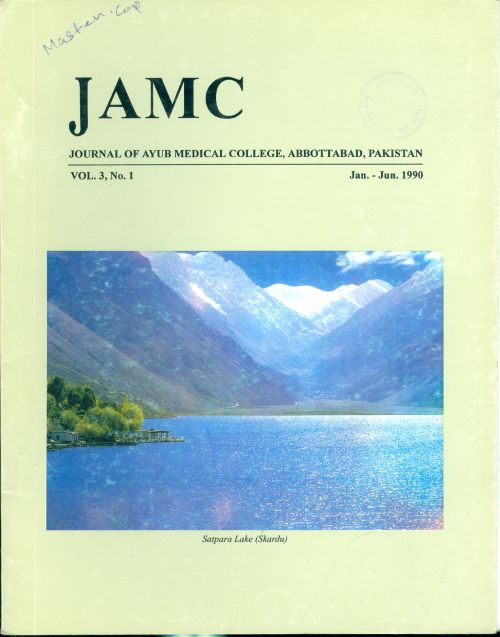EFFECT OF ALTITUDE ON SPIROMETRIC VALUES
Abstract
ABSTRACT:A total of 132 healthy male subjects from Haripur, Abbottabad and Nathiagali were tested fortheir lung volumes and flow rates. The spirometric values from Haripur and Abbottabad arecomparable to other studies carried out in Pakistan. It was found that there were no significantdifferences in FEV1 and FEV1 /FVC% of the subjects but the FVC of the subjects from Nathiagaliwas found to be significantly higher than the lowlanders. Moreover, the rate of decline in the lungvolumes and especially the flow rates of the subjects from Nathiagali was higher than thelowlanders. Further insight in the problem is suggested.References
Prieto, F., English, M.J., Cochrane, G.M., Clark, T.J.H., and Rigden, 13.G. (1978). Spirometry in healthy men: a
correlation with smoking and with mild symptoms. Thorax, 33: 322-7.
Committee Recommendations (1975). The assessment of Ventilatory Capacity Statement of the Committee on
Environmental Health and Respiratory Physiology, American College of Chest Physicians. Chest, 67: 95-7.
Knudson, R.J, Leibowitz, M.D., Holberg, C.J., and Burrows, B, (1983). Changes in the Normal Maximal Expiratory
Flow-Volume Curve with Growth and Aging. Am. Rev. Respir. Dis., 127: 725-34.
Leech, J.A., Ghezzo, H., Stevens, D., and Becklake, M R., (1983). Respiratory Pressures and Functions in Young Adults.
Am. Rev. Respir. Dis., 128: 17-23.
Ayub, M., Zaidi, S.H., and Burki, N.K. (1987). Spirometry and flow-volume curves in healthy normal Pakistanis. Br. J.
Dis. Chest, 81: 35-45.
Kryger, M. (1980). Breathing at High Altitude: Lessons Learned and Application to Hypoxemia at Sea Level. Adv.
Cardiol., 27: 11-6.
Miller, G.J., Saunders, M.J., Gilson, R.J.C., and Ashcroft, F.T. (1977). Lung function of healthy boys and girls in Jamica
in relation to ethnic composition, test exercise performance and habitual physical activity Thorax, 32: 486-96.
Lawther, P.J., Brooks, A.G.F , and Waller, R E. (1978). Respiratory function measurements in a cohort of medical
students: a ten-year follow-up. Thorax, 33: 773-8.
Schoenberg, J.B., Beck, G.J., and Bouhuys, A. (1978). Growth and decay of Pulmonary Function in healthy blacks and
whites. Respiratory Physiology’, 33: 367-93.
Sliman, N.A. (1984). The Effect of Altitude on Normal Pulmonary Function Tests: A Comparison Between the Dead
Sea Area and Amman. Avia/. Space and Environ. Med., 55: 1010-4
Malik, M.A., Moss, E., and Lee, W.R. (1972). Prediction values for the ventilatory' capacity in male West Pakistani
workers in the United Kingdom. Thorax, 27: 611-9.
Williams. D.E., Miller, R.D., and Taylor, W.F (1978). Pulmonary function studies in healthy Pakistani adults. Thorax.
: 243-9.
Rati. F., and Bano, M., (1982). Pulmonary Function Tests in the Normal Pakistani Population. JPMA, 32(1). 9-13.
Younas, A., Ahmed, Q.R., Hussain, M., and Rashid, A. (1986). Comparison of spirometric variables between heavy
cigarettes smokers and nonsmokers RMJ. XV(I1I & IV): 21-4.
Jain, S.K., and Rarniah. T.J. (1969). Normal standards of pulmonary function tests for healthy Indian men 15-40 years
old. Comparison of different regression equations (Predicted formulae), hid. J Med. Res., 57(8): 1453-66.
Oxhoj, H., Jeppesen. G.M.. Larsen, V.H., and Jorgensen, B, (1988) Spirometry in healthy adult never- smokers. Clinical
Physiology>, 8 329-39.
Cochrane, G.M., Prieto, F.. and Clark, T.J.11 (1977). Intrasubject variability of maximal expiratory flow volume curve.
Thorax, 32: 171 -6.
West, J.B. (1980). Respiratory Physiology in Unusual Environment. In Respiratory Physiology, the essentials. 2nd Ed.
pp 128-30. Williams and Wilkins Company, Baltimore.
Burki, N K.. (1982). Pulmonary Function Tests. In Pulmonary Diseases, 1st Ed. pp 33-68. Medical Examination
Publishing C. Inc., an excerpta Medical Company, Garden City New York. U.S.A,
Issue
Section
License
Journal of Ayub Medical College, Abbottabad is an OPEN ACCESS JOURNAL which means that all content is FREELY available without charge to all users whether registered with the journal or not. The work published by J Ayub Med Coll Abbottabad is licensed and distributed under the creative commons License CC BY ND Attribution-NoDerivs. Material printed in this journal is OPEN to access, and are FREE for use in academic and research work with proper citation. J Ayub Med Coll Abbottabad accepts only original material for publication with the understanding that except for abstracts, no part of the data has been published or will be submitted for publication elsewhere before appearing in J Ayub Med Coll Abbottabad. The Editorial Board of J Ayub Med Coll Abbottabad makes every effort to ensure the accuracy and authenticity of material printed in J Ayub Med Coll Abbottabad. However, conclusions and statements expressed are views of the authors and do not reflect the opinion/policy of J Ayub Med Coll Abbottabad or the Editorial Board.
USERS are allowed to read, download, copy, distribute, print, search, or link to the full texts of the articles, or use them for any other lawful purpose, without asking prior permission from the publisher or the author. This is in accordance with the BOAI definition of open access.
AUTHORS retain the rights of free downloading/unlimited e-print of full text and sharing/disseminating the article without any restriction, by any means including twitter, scholarly collaboration networks such as ResearchGate, Academia.eu, and social media sites such as Twitter, LinkedIn, Google Scholar and any other professional or academic networking site.









